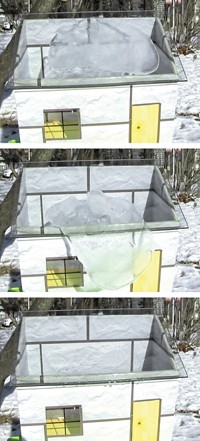Advertisement
Grab your lab coat. Let's get started
Welcome!
Welcome!
Create an account below to get 6 C&EN articles per month, receive newsletters and more - all free.
It seems this is your first time logging in online. Please enter the following information to continue.
As an ACS member you automatically get access to this site. All we need is few more details to create your reading experience.
Not you? Sign in with a different account.
Not you? Sign in with a different account.
ERROR 1
ERROR 1
ERROR 2
ERROR 2
ERROR 2
ERROR 2
ERROR 2
Password and Confirm password must match.
If you have an ACS member number, please enter it here so we can link this account to your membership. (optional)
ERROR 2
ACS values your privacy. By submitting your information, you are gaining access to C&EN and subscribing to our weekly newsletter. We use the information you provide to make your reading experience better, and we will never sell your data to third party members.
Environment
Patent Picks: Marine Coating Technologies
A look at recent patenting activity in environmentally friendly marine coatings, brought to you by C&EN and CAS
by Mitch André Garcia
January 25, 2016
| A version of this story appeared in
Volume 94, Issue 4

Marine organisms such as algae, bacteria, and barnacles can grow on the hulls of ships, creating drag and making the vessels less fuel efficient. So shipbuilders apply coatings to the metal hulls to try to frustrate these biological hangers-on. In 2008, the United Nations’ International Maritime Organization banned paints containing tributyltin, a formidable biocide, because they often leach the toxic compound into the environment. Ever since, paint companies have searched for the perfect coating that can deter sea life from attaching to vessels without harming the environment. Using polymer science, nanotechnology, and materials science, some researchers have developed nonbiocidal coatings that repel sea creatures solely by the physical and chemical properties of the coatings. Other researchers have incorporated environmentally friendly antifouling agents into marine paints. Here, we highlight three advances in environmentally friendly marine coatings from the databases of Chemical Abstracts Service (CAS).
Jump to Topics:
- Zwitterionic Polymer Prevents Cell Adhesion
- Shearing Barnacles With A Hydrophobic Polymer
- Capsaicin Spray Paint Repels Shellfish
↑ Top
Zwitterionic Polymer Prevents Cell Adhesion
One known way to prevent proteins and cells from attaching to ship hulls is to coat them with zwitterionic polymers. These polymers, which contain multiple positive and negative charges, achieve their antifouling properties by strongly attracting a layer of water molecules that block organisms’ access to a hull’s surface. But zwitterionic polymers often form soft hydrogels in water, decreasing their mechanical integrity. To increase the stability of such coatings, James H. Wynne and Peter N. Coneski of the Naval Research Laboratory created a zwitterionic polyurethane material derived from carboxybetaine (US 20150353474) that behaves as a hydrogel only at the coating’s surface, not throughout its bulk. The polymer becomes zwitterionic after treatment with a strong base. The base-catalyzed reaction is diffusion-controlled, so the researchers can control how much of the coating becomes soft. Wynne tells C&EN that they have tested the polymer’s effectiveness under maritime conditions and have found that it works on a large variety of marine-fouling organisms.
↑ Top
Shearing Barnacles With A Hydrophobic Polymer
Hydrophobic polymers, such as polydimethylsiloxane (PDMS), don’t allow marine organisms to attach themselves firmly to ship hulls. This allows the drag created as the ships move through the water to easily knock off the organisms. However, PDMS is soft and rubbery and it easily wears off with time. These physical properties have prevented the polymer from finding broad utility as a marine antifouling coating. Dow Global Technologies scientists Paul J. Popa, Yanxiang Li, and Hongyu Chen have overcome these limitations by improving the mechanical properties of PDMS-based coatings through covalently bonding polyurethane to the material (US 20150307745). They synthesized their polymer by reacting isocyanate-functionalized PDMS and polyurethane polymers with the help of a small-molecule linker, Dow’s DWD 2080. To determine whether the new PDMS-based coating could help shear sea critters off ships, the researchers performed a pseudobarnacle pull-off test. The test involves gluing a 10-mm aluminum rod to a surface coated with their PDMS-based polymer and measuring the amount of force it takes to pull it off. Under all conditions reported, the forces required were within range of the shearing forces created by a ship traveling through the sea.
↑ Top
Capsaicin Spray Paint Repels Shellfish
Benming Li, a scientist at Qingdao Wuwei Insulation Materials Co., invented an easy way to add antifouling properties to a metallic ship: spray-paint chili powder (CN 104549961). The mixture contains typical water-resistant paint compounds such as fluorinated acrylate, silicone rubber, and propylene glycol. Li then adds a concoction of various antifouling agents including cinnamic acid, tannic acid, and capsaicin—the spicy compound in chili peppers. Laboratory tests showed that shellfish and single-celled protists did not attach to spray-painted metal surfaces. Additionally, Li reports that the coated metal surfaces were resistant to rust and corrosion.
Mitch Garcia wrote this month’s Patent Picks in collaboration with CAS. This feature reports on trends CAS scientists observe from patents in CAS databases. Please send comments and suggestions to patentpicks@acs.org.







Join the conversation
Contact the reporter
Submit a Letter to the Editor for publication
Engage with us on Twitter